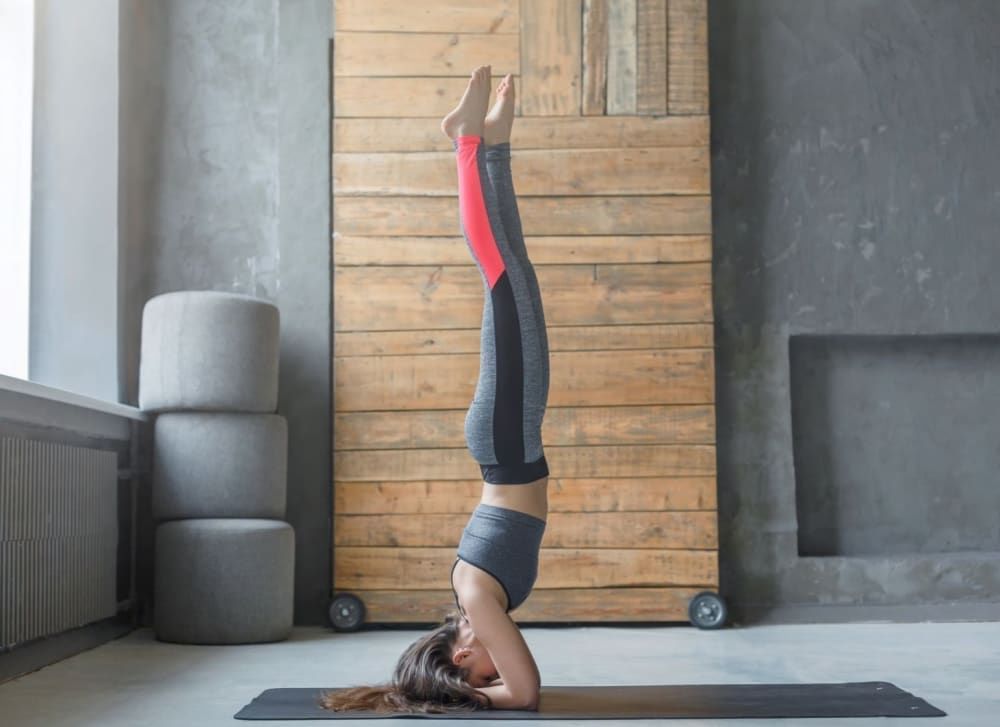12 Awesome Head Stand Benefits on Health - Bodywise

Often called the king of asanas, the Sanskrit word for posture, the headstand is an advanced yoga inversion.
The headstand requires you to turn your body upside down, so there are a few safety precautions to be aware of. It's also important to have fun.
You can build upon your current level of headstand practice, whether you're a beginner or want to perfect your current technique. In this article, you'll find some tips for safely and effectively doing a headstand, as well as how to do a headstand.
What Is A Headstand?
The purpose of yoga is manifold. Performing yoga asanas not only build muscle, strength, and physical energy but also alleviate stress, tension, and anxiety.
A headstand is a static hold and a yoga posture that involves immense strength and control. Also known as ‘sirsasana’, the headstand calls for bodily inversion. Physical and mental balance is maintained by holding a headstand position.
Head Stand Benefits
When performed correctly, a headstand pose has multiple health benefits for overall well-being. Read on for some helpful headstand yoga benefits for women:
1) Headstand relieves stress
Did you know the headstand is also referred to as a ‘cooling posture’? This essentially indicates that the headstand pose allows an individual to draw attention inwards. The breath control executed while performing a headstand helps keep worrisome thoughts and anxiety at bay.
2) Headstand increases focus
The headstand position requires an individual to be upside down. An inverted position increases blood flow to the brain, improving focus. Performing headstands is essential to improve cognitive abilities and keep thoughts sharp and clear.
3) Headstand is beneficial for the eyes
When an individual’s body is flipped while performing a headstand, fresh oxygen supply and rich nutrients reach the eyes. This helps prevent macular degeneration and other similar eye complications.
4) Headstand strengthens the upper body
The shoulders and arms are predominantly used to propel your legs upwards and keep the body balanced while performing a headstand. With repeated practice, a headstand will straighten your posture and improve muscular endurance and core and upper body strength.
5) Headstand improves gut health
Being upside down and reversed makes the blood rush to the digestive organs. Doing a headstand releases trapped gas, increases absorption of nutrients in the stomach, and enhances digestion. The sirsasana is an ideal yoga posture for those who experience constipation and other gut problems.
6) Headstand helps take the pressure off your feet
Edema refers to the excessive swelling of any body part due to trapped fluids in the tissues. If one’s professional life requires standing for long hours, foot bloating may occur and cause further problems. Holding a headstand goes against the effects of gravity, flushing out fluids trapped in the feet.
7) Headstand stimulates the lymphatic system
The network of nodes in the body’s lymphatic system clears waste products from the blood. When one flips over on their head, the lymphatic system is activated directly, cleansing toxins from the body.
8) Headstand flushes out adrenal glands
Do you know the function of the adrenal glands? These glands are responsible for producing stress hormones such as cortisol in the body. A headstand position squeezes the adrenal glands, ensuring their optimal functioning.
9) Headstand increases lung capacity
It is no secret that performing yoga daily requires expert breath control. If you have been learning how to do a headstand daily, your lung functioning and capacity will greatly improve.
10) Headstand helps relieve menopause symptoms
Women can often get tired with medication for menopause symptoms. Luckily, yoga and performing headstands naturally alleviates moodiness and hot flashes induced by menopause.
11) Headstand benefits for hair
The inverted position of a headstand enhances blood circulation to the scalp. Adequate blood flow to the scalp not only reduces hair loss but also prevents premature greying. Another headstand benefit for the hair is that it aids dormant hair follicles to reach their maximum growth capacity, ensuring new and voluminous growth.
12) Headstand benefits for skin
Performing a headstand reverses the flow of gravity in the body. How does this benefit your skin? When your skin hangs in the opposite direction, fresh blood flow to the facial region is stimulated, leading to glowing and radiant skin.
How to Do a Headstand
Instructions
- Take the Thunderbolt Pose.
- Place opposite hands at the inside base of your upper arms to determine the elbow width.
- When you place your elbows on your mat, keep your elbows in this position.
- Create a triangle shape with your forearms by bringing your hands together.
- As you interlace your fingers, open your palms and thumbs.
- Put the tips of your pinky fingers together to form a stable base for your hands.
- Place your head inside your hands on the mat.
- Straighten your legs and lift your hips.
- Put your hips above your shoulders as you walk your feet toward your head.
- Kneel gently towards your chest.
- Hold this position for 5 seconds.
- Slowly straighten your legs.
How to Do a Headstand for Beginners
To perform a headstand safely, you need a certain level of strength and skill. Let's discuss that a bit more - and give some modifications - but first, here's how to do the full-on posture -
- Place your yoga mat next to a wall. You can fold over a thin mat to provide more cushion.
- Stand on all fours facing the wall.
- As you come down onto your forearms, interlace your fingers along the webbing all the way up. Your knuckles should be about half an inch from the wall, and your elbows should be no wider than your shoulders.
- Place your crown on the ground and cup your hands behind your head.
- Lift your knees and toes off the ground to elevate your pelvis, strength and skill level, doing and your legs are as straight as possible (a slight bend in the knees is okay).
- Place your feet in front of your elbows so that your shoulders are directly over the elbows. Next, lift your shoulders off the floor to create length in your neck.
- Continue to walk forward until your shoulders are slightly above your elbows.
- Put your heel on your sitz bones by bending one knee and engaging your abs to pull it into your chest without moving your head. Repeat with your other knee. Place your feet against a wall and place your pelvis against it.
- Slowly extend one leg up toward the wall. Do the same with the other leg. Keep your feet flexed and heels on the wall.
- Pull your heels and hips away from the wall if you feel stable.
- Hold this position for five breaths.
- Bend your knees and curl them towards your chest, one by one, as you reverse the move. Rest in the child's pose.
Pro Tips
1) Avoid compressing your head and neck
It is essential to have upper body and core strength to maintain your balance during a headstand. This will prevent you from putting too much pressure on your head or neck.
Make sure that you don't compress this area of your body. If you're putting too much weight on your head, draw the energy of your elbows inward to strengthen your foundation.
2) Engage your core
Maintain your body alignment and engage your core the entire time. Draw your navel into your spine.
3) Find the correct spot on your head before placing it on the floor
You can find the correct spot on the top of your head by placing your palm against your face, starting at the top of your nose.
Place your middle finger on the top of your head, which is where your head will touch the floor. Stimulate this area and then place this spot on the floor a few times to experience how it feels.
4) Build strength in your arms
If you want to train your arms, use a yoga strap. This resistance will help you develop strength in your arms and prevent your elbows from widening. Simply place the strap above your elbows at the base of your upper arms before executing the pose.
Safety Measures
Here are some basic precautions and rules one must keep in mind while performing a headstand:
- Performing a headstand applies pressure on your back and spine. Ensure you have an expert to spot and assist you while performing this pose.
- If you are a beginner, it is completely alright to use a wall for support.
- Place cushions, bellows, and blankets around you in case you fall over to prevent the risk of injury.
- Avoid doing headstands if you:
- Experience frequent back pain
- Suffer from osteoporosis
- Have a heart condition
Headstand Variations
- Wide-legged headstand
- Baddha Konasana headstand
- Eagle-legged headstand
- Lotus-legged headstand
Headstand vs Handstand
In the argument of headstand vs handstand, headstands win. Headstands are easier to perform compared to handstands. There is a broader surface area or base in doing a headstand, including your crown and both palms. Handstands require the entire body weight to rest on both palms, making it more challenging to hold.
Summing Up on Head Stand Benefits
A headstand can be a valuable addition to a yoga practice, giving you physical benefits as well as a sense of accomplishment.
As you master some of these preliminary poses, gradually progress to doing a headstand. Safety is the most important factor, so take all precautions.
If you experience any tension or pain after practicing, listen to your body and take a break.
Faqs
1) Is Head Stand Good for Brain?
Practising headstand can improve memory, cognitive abilities, and other mental activities. Headstand yoga improves blood flow to the brain, rejuvenating brain cells and increasing cognitive ability.
2) Is It Good to Do Headstand Every day?
Yoga experts highly recommend doing a headstand every day to reap the benefits of the posture's benefits on your health, digestion, hormone balance and stress relief.
3) What Muscles Does a Head Stand Work?
The entire core, shoulders, and upper back are worked during headstands. The deltoid muscles are also engaged when you protract your shoulders (like when holding a beach ball in your hands). In addition, your triceps and pecs (chest) are used when pushing off the ground and when carrying the ball.
4) Can Headstands Increase Height?
Yoga poses such as headstands are often used for height gain because it improves the functioning of the hypothalamus, pituitary glands, thus improving the function of endocrine glands.

